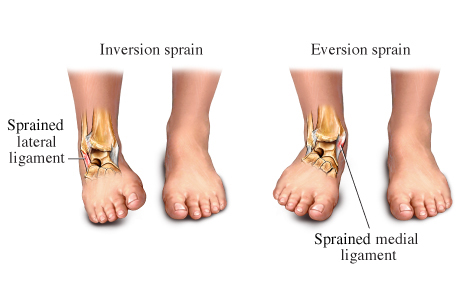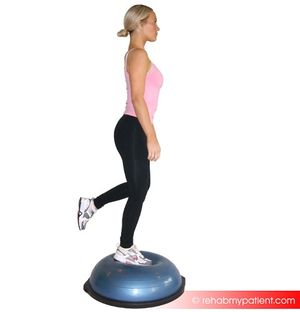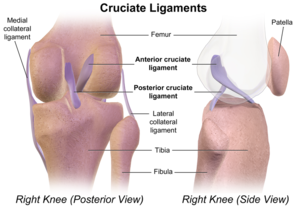Ligament Sprain
Original Editor - Rachael Lowe
Top Contributors - Wanda van Niekerk, Lucinda hampton, Admin, Rachael Lowe, Kim Jackson and WikiSysop
Introduction[edit | edit source]
A sprain is an injury to the band of collagen tissue i.e. a ligament, which connects two or more bones to a joint. The primary function of a ligament is to provide passive stabilisation of a joint and it plays an important role in proprioceptive function.[1] A sprain is usually caused by the joint being forced suddenly outside its usual range of movement and the inelastic fibres are stretched through too great a range. For example, excessive inversion of the ankle can cause the lateral ankle ligaments, primarily the anterior talofibular ligament, to rupture. A severe sprain may look and feel like a break (fracture), and it can be difficult for health professionals to tell the difference between the two.[2] A ligament rupture can occur at the midsubstance of the ligament or at the ligament-bone junction.[1] Sometimes an avulsion fracture also occurs (the ligament pulls a piece of bone with it on injury). The image shows an example of a sprain of the ankle.
Grades of Injury[edit | edit source]
A sprain can range from mild (tearing of just a few fibres) to severe (complete rupture of the ligament, leading to joint instability).
The severity of a sprain is graded according to how badly the ligament has been damaged and whether or not the joint has been made unstable. The joint can become unstable when the damaged ligament is no longer able to give it the normal support[2]:
- Grade I - structural damage only on microscopic level, with slight local tenderness and without joint instability.[1]
- Grade II - partial tear (rupture) of the ligament, visible swelling and noticeable tenderness, but without joint instability (or with mild instability).[1]
- Grade III - a severe sprain: complete rupture of the ligament with significant swelling and with instability of the joint.[1]
Mild to moderate sprains are treated conservatively and normally heal after 6 weeks.
The below video gives a brief overview of ligament sprains.
Physiotherapy[edit | edit source]
Physiotherapy treatment aims include[4]:
- Prevention of abnormal scar tissue formation, joint stiffness, muscle weakness
- Restore proprioceptive deficits
- Pain relief through joint mobility techniques, soft tissue massage, electrotherapy
- Improving scar tissue quality using techniques to guide the direction it forms
- Loosening or strengthening of the injured region with individually prescribed exercises and techniques.
- Improving performance when the client returns to sport, work or simply daily life.
- Correct any biomechanical faults that may be affecting movement, technique or predisposing the client to injury.[4]
The amount of rehabilitation and the time needed for full recovery after a sprain or strain depend on the severity of the injury and individual rates of healing. For example a moderate ankle sprain may require 3 to 6 weeks of rehabilitation before a person can return to full activity. A severe sprain can take 8 to 12 months before the ligament is fully healed. Extra care should be taken to avoid re-injury.
Early Rehabilitation Strategies[edit | edit source]
Management of ligament sprains includes first aid immediately post-injury:
Early to Late Rehabilitation Strategies[edit | edit source]
- Therapeutic exercises[5]
- Neuromuscular re-education[5][6][7]
- Proprioception
- Supervised rehabilitation[5][6][7]
- Educational/counseling strategies[6]
- Surgical intervention if necessary[2]
- A moderate or severe sprain, particularly of the ankle, may require a hard cast may be applied. Severe sprains may require surgery to repair or reconstruct the torn ligaments. Surgery is usually performed by an orthopaedic surgeon.[2]
- Sport or activity modification[5]
- Return to sport readiness[5]
- Surgical intervention if necessary[2]
See our individual Physiopedia pages on particular ligament injuries and their specific treatments. (ACL injury, Medial collateral knee injury, Ankle Sprain, Shoulder Instability)
Medications[edit | edit source]
The following medicines may be prescribed:
- Paracetamol is useful to ease pain (best taken regularly, for a few days or so, rather than every now and then). If the pain is more severe, stronger painkillers such as codeine, is sometimes prescribed.[2]
- Non-steroidal anti-inflammatory drugs (NSAIDs) can relieve pain and may also limit inflammation and swelling.[5]
- Rub-on (topical) anti-inflammatory painkillers. Some studies suggest that they may be as good as tablets for treating sprains. Other studies suggest they are no better than an embrocation. However, the amount of medicine that gets into the bloodstream is much less than with tablets, and there is less risk of side-effects.[2]
Common Ligament Injuries[edit | edit source]
Common areas of ligament injuries include the following:[4]
Knee Ligament Injuries[edit | edit source]
- ACL Injury
- PCL Injury
- MCL Sprain
- LCL Sprain
- Posterolateral Corner Injury
- Patella Dislocation
- Superior Tibiofibular Joint Sprain
Ankle Ligament Injuries[edit | edit source]
Shoulder Ligament Injuries[edit | edit source]
Wrist and Hand Ligament Injuries[edit | edit source]
Spinal Ligament Injuries[edit | edit source]
Also have a look and compare a ligament sprain to a muscle strain.
Resources[edit | edit source]
Knee Ligament Sprain Guidelines: Revision 2017: Using the Evidence to Guide Physical Therapist Practice.[6]
Diagnosis, treatment and prevention of ankle sprains: update of an evidence-based clinical guideline.[7]
References[edit | edit source]
- ↑ 1.0 1.1 1.2 1.3 1.4 Bahr R, Alfredson H, Järvinen M, Järvinen T, Khan K, Kjær M, Matheson G, Mæhlum S. Types and Causes of Injuries. In Bahr. R. The IOC Manual of Sports Injuries: An Illustrated Guide to the Management of Injuries in Physical Activity. Wiley Blackwell. 2012. p 1-24.
- ↑ 2.0 2.1 2.2 2.3 2.4 2.5 Patient Sprains and Strains 2018. Available from: https://patient.info/bones-joints-muscles/sports-injuries/sprains-and-strains (last accessed 5.12.2019)
- ↑ WS Westford Ligament tear Available from: https://www.youtube.com/watch?v=5Gqw9aCMvwE&app=desktop (last accessed 5.12.2019)
- ↑ 4.0 4.1 4.2 Physioworks What to do after a Muscle Strain or Ligament Sprain? Available from: https://physioworks.com.au/treatments-1/what-to-do-after-a-muscle-strain-or-ligament-sprain (last accessed 5.12.2019)
- ↑ 5.0 5.1 5.2 5.3 5.4 5.5 5.6 5.7 5.8 Bahr R, Cook J, Langberg H, MacAuley D, Matheson G and Mæhlum S. (2012). Treating Sports Injuries. In Bahr R. (Ed). The IOC Manual of Sports Injuries. Wiley Blackwell 2012.p 25-39.
- ↑ 6.0 6.1 6.2 6.3 6.4 6.5 Knee Ligament Sprain Guidelines: Revision 2017: Using the Evidence to Guide Physical Therapist Practice. J Orthop Sports Phys Ther. 2017 Nov;47(11):822-823.
- ↑ 7.0 7.1 7.2 7.3 Vuurberg G, Hoorntje A, Wink LM, et al. Diagnosis, treatment and prevention of ankle sprains: update of an evidence-based clinical guideline. British Journal of Sports Medicine 2018;52:956.









